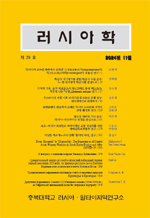러시아 просторечие에 관한 통시적 고찰
A Diachronic Study on Vernacular(Prostorečie) in Russian
- 충북대학교 러시아 알타이지역 연구소
- 러시아학
- 제30호
-
2025.051 - 26 (26 pages)
-
DOI : 10.24958/rh.2025.30.1
- 12

러시아어 발달사에서 ПР의 의미상 기원이 될 수 있는 어휘는 『지나간 세월에 관한 이야기』 1090년 항 서술에 처음 등장하여 17세기 초반까지 산발적으로 사용되다, 17세기 중반 바쉬막 편지에서 온전한 어휘로서 просторечие가 예증된다. 17세기 중후반 아바쿰 생애전에서 구체적 의미를 나타내며 좀 더 빈번히 사용되었으며, 18세기 초 표트르대제시기에는 문어의 의식적인 ПР화가 이루어졌다. 18세기 중반 로모노소프에 의해 ПР가 문어의 틀 안으로 들어왔고, 18세기 말 사전의 표시어로서 ПР가 처음 등장하였다. 이 시기 ПР의 내용이 지역 및 사회적 방언을 제외하고 살아있는 모든 말을 일컬으며 ПН를 포함하였지만, 19세기 초 ПН가 거침과 조야함, 비식자성의 표지가 되며 ПР와 구분되었다. 러시아표준어가 형성되기 시작하던 19세기 전반 ПР와 ПН의 대립은 현대러시아 언어학적 의미의 РР과 ПР의 대립으로 전환되었다. ПР는 코이네를 기원으로 하며 시대마다 의미하는 바가 다소간의 차이를 보이지만 19세기 전반까지 관통하는 공통된 의미는 비교회슬라브어, 즉 비문어라는 점으로, 좀 더 자세히 언급하면 다음과 같다. 11 - 17세기 중반까지 ПР는 코이네와 문자화한 성지 순례기 및 여행기 언어를 의미하고, 17세기 중후반부터는 표준적 교회슬라브어인 красноречие에 대립적으로 사용되었다. 표트르대제시기에는 교회슬라브어를 코이네로 대체하는 것이 ПР의 실현으로 인식되며 문어인 교회슬라브어를 비문어인 코이네로 대체하기 시작하였는데, 이 작업은 문어성에 대한 통일된 표상이 없는 상황에서 각 문헌가의 개별적 시도였으므로 교회슬라브어와 비교회슬라브어가 혼합된 텍스트가 매우 빈번히 출현하였다. 즉 표트르대제 시기에 문어와 ПР의 경계가 자연스럽게 와해하기 시작하였고, 뒤이어 로모노소프의 삼문체론에서 ПР가 문어의 틀 안으로 들어와 문체적 의미를 획득하게 되었다. 18세기 말 ПН를 포함하며 ПР의 내용이 확장되었지만, 19세기 러시아 표준어가 형성되는 과정에서 거칠고 조잡한 ПН가 다시 ПР에서 배제되어, ПР가 현대러시아 언어학적 의미의 РР로, 그리고 ПН가 ПР로 전환되었다. 이리하여 전통적인 문어와 현대러시아 언어학적 의미의 속어 ПР 사이의 완충지에 구어 РР가 위치한다.
In the history of the development of the Russian language, vocabulary that could be the semantic origin of “prostorečie” first appeared in the 1090 section of Povesti vremennyx let and was used sporadically until the early 17th century. Prostorečie is exemplified as a complete vocabulary in the Bašmak Letter in the mid-17th century. In the mid to late 17th century, it was used more frequently to indicate specific meanings in the Life of Archpriest Avvakum, and during the reign of Peter the Great in the early 18th century, the bookish language was consciously transformed into ПР. In the mid-18th century, ПР was brought into the framework of bookish language by Lomonosov, and ПР first appeared as a marker word in dictionaries at the end of the 18th century. During this period, the content of ПР referred to all living languages excluding regional and social dialects and included ПН, but in the early 19th century, ПН became a sign of roughness, crudeness, and illiteracy, and was distinguished from ПР. In the first half of the 19th century, when the Russian literary language was beginning to form, the opposition between ПР and ПН was transformed into an opposition between РР and ПР in the modern Russian linguistic sense. ПР has its origins in koine, and although its meaning varies somewhat from era to era, the common meaning that lasted until the first half of the 19th century is that it is a non-Church Slavic language, that is, a nun-bookish language. To discuss it in more detail, it is as follows. 11th - until the mid-17th century, ПР meant koine and the written language of pilgrimage and travelogues, and from the mid-to-late 17th century it was used as an antithesis to the standard Church Slavonic, i.e., красноречие. During the reign of Peter the Great, the replacement of Church Slavonic with koine was recognized as the realization of ПР, and Church Slavonic began to be replaced with the non-bookish, koine. Since this work was an individual attempt by the literati in the absence of a unified representation of bookish language, it was not an uncommon phenomenon for texts mixed with Church Slavonic and non-Church Slavonic to appear. In other words, during the time of Peter the Great, the boundary between the bookish language and ПР naturally began to collapse, and subsequently, in Lomonosov's three style system, ПР came into the framework of the bookish language and acquired stylistic meaning. At the end of the 18th century, the content of ПР was expanded to include ПН, but in the process of forming Russian literary language in the 19th century, the rough and crude ПН was again excluded from ПР, turning ПР into РР in the modern Russian linguistic sense, and ПН into ПР. The РР is located in the buffer between the traditional bookish language and ПР of the modern Russian linguistic meaning.
I. 들어가는 말
II. 현대러시아 언어학에서 ПР의 개념 및 특징
III. 러시아 ПР의 기원: 러시아 코이네(койне)
IV. 11 - 19세기 러시아 ПР의 변화
V. 맺음말
참고문헌
(0)
(0)